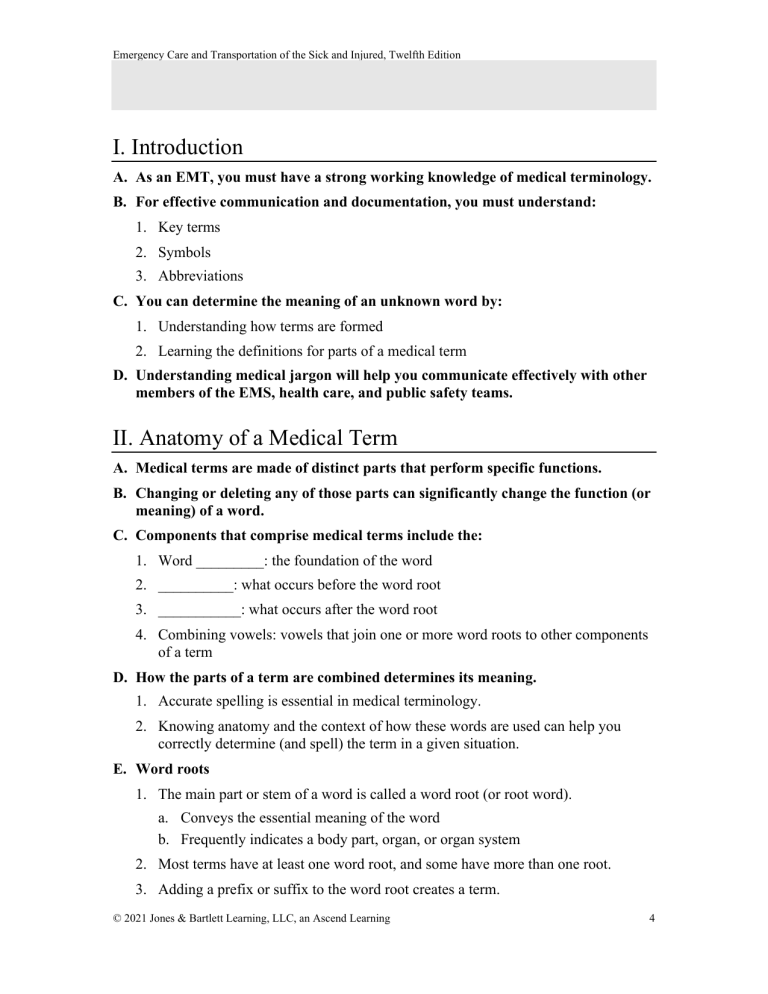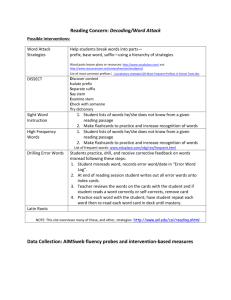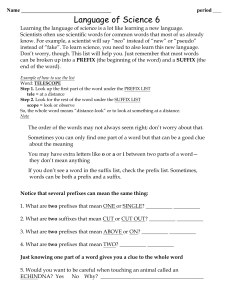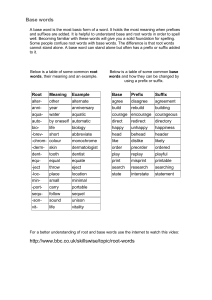
Emergency Care and Transportation of the Sick and Injured, Twelfth Edition Chapter 5: Medical Terminology I. Introduction A. As an EMT, you must have a strong working knowledge of medical terminology. B. For effective communication and documentation, you must understand: 1. Key terms 2. Symbols 3. Abbreviations C. You can determine the meaning of an unknown word by: 1. Understanding how terms are formed 2. Learning the definitions for parts of a medical term D. Understanding medical jargon will help you communicate effectively with other members of the EMS, health care, and public safety teams. II. Anatomy of a Medical Term A. Medical terms are made of distinct parts that perform specific functions. B. Changing or deleting any of those parts can significantly change the function (or meaning) of a word. C. Components that comprise medical terms include the: 1. Word _________: the foundation of the word 2. __________: what occurs before the word root 3. ___________: what occurs after the word root 4. Combining vowels: vowels that join one or more word roots to other components of a term D. How the parts of a term are combined determines its meaning. 1. Accurate spelling is essential in medical terminology. 2. Knowing anatomy and the context of how these words are used can help you correctly determine (and spell) the term in a given situation. E. Word roots 1. The main part or stem of a word is called a word root (or root word). a. Conveys the essential meaning of the word b. Frequently indicates a body part, organ, or organ system 2. Most terms have at least one word root, and some have more than one root. 3. Adding a prefix or suffix to the word root creates a term. © 2021 Jones & Bartlett Learning, LLC, an Ascend Learning 4 Emergency Care and Transportation of the Sick and Injured, Twelfth Edition Chapter 5: Medical Terminology 4. Changing the prefix or suffix will change the meaning of the term. 5. Some word roots may also be used as prefixes or suffixes for other terms. F. Prefixes 1. ________ usually describe: a. Location b. Intensity 2. Not all medical terms have prefixes. 3. A prefix gives the word root its specific meaning. 4. By learning the commonly used medical prefixes, you can figure out the meaning of terms that may not be familiar to you. G. Suffixes 1. __________ usually indicate a: a. b. c. d. Procedure Condition Disease Part of speech H. Combining vowels 1. A combining vowel is the part of a term that connects a word root to a suffix or other word root. a. In most cases, it is an o; however, it may also be an i or an e. b. Used when joining a suffix that begins with a consonant or when joining another word root. 2. The combining vowel helps ease the pronunciation of the term. 3. A combining form is a combining vowel shown with the word root. III. Word Building Rules A. The following summarizes the rules covered thus far: 1. The prefix is always at the ____________ of a term; however, not all terms will have a prefix. 2. The suffix is always at the ________ of the term. 3. Use a combining vowel when: a. A suffix begins with a consonant (to make pronunciation easier). b. A term has more than one word root; a combining vowel must be placed between the two word roots, even if the second root begins with a vowel. © 2021 Jones & Bartlett Learning, LLC, an Ascend Learning 5 Emergency Care and Transportation of the Sick and Injured, Twelfth Edition Chapter 5: Medical Terminology IV. Plural Endings A. To change a term from singular to plural form, certain rules apply. B. Sometimes you can simply add an s (lung becomes lungs), but some rules are more complicated. C. Rules you may encounter when converting from singular to plural terms are: 1. Singular words that end in a change to ae. 2. Singular words that end in is change to es. 3. Singular words that end in ex or ix change to ices. 4. Singular words that end in on or um change to a. 5. Singular words that end in us change to i V. Special Word Parts A. Prefixes can be used to indicate: 1. Numbers 2. Colors 3. Positions and directions B. Numbers 1. Several prefixes are used to indicate if a term involves a number, such as half, one or two (or more) parts or sides. a. Examples: uni-, dipl-, null-, primi-, multi-, biC. Color 1. Several word roots are used to describe color. a. Examples: cyan/o, leuk/o, erythr/o, cirrh/o, melan/o D. Positions and directions 1. Prefixes can also be used to describe a position, direction, or location. a. Examples: ab-, ad-, de-, circum-, peri-, trans-, epi-, supra- VI. Common Direction, Movement, and Position Terms A. ______________ terms 1. Common directional terms include: a. Right and left b. Superior and inferior c. Lateral and medial © 2021 Jones & Bartlett Learning, LLC, an Ascend Learning 6 Emergency Care and Transportation of the Sick and Injured, Twelfth Edition Chapter 5: Medical Terminology d. e. f. g. h. Proximal and distal Superficial and deep Ventral and dorsal Palmar and plantar Apex 2. The terms right and left refer to the _____________ right and left sides, not to your right and left sides. 3. Superior and inferior a. The ____________ part of any body part is the portion nearer to the head from a specific reference point. The part nearer to the feet is the ____________ portion. b. These terms are also used to describe the relationship of one structure to another. 4. Lateral and medial a. Parts of the body that lie farther from the midline are called lateral (outer) structures. b. The parts that lie closer to the midline are called medial (inner) structures. 5. Proximal and distal a. Describe the relationship of any two structures on an extremity. b. _____________ describes structures that are closer to the trunk. c. ___________ describes structures that are farther from the trunk or nearer to the free end of the extremity. 6. Superficial and deep a. _____________ means closer to or on the skin. b. ____________ means farther inside the body or tissue, and away from the skin. 7. Ventral and dorsal a. Ventral refers to the belly side of the body, or the anterior surface of the body. b. Dorsal refers to the spinal side of the body, or the posterior surface of the body, (think of the dorsal fin of a dolphin, which is on its back). c. The more commonly used terms are anterior (the front surface of the body) and posterior (the back surface of the body). 8. Palmar and plantar a. The front region of the hand is referred to as the palm or palmar surface. b. The bottom of the foot is referred to as the plantar surface. 9. Apex a. The ___________ (plural: apices) is the tip of a structure. © 2021 Jones & Bartlett Learning, LLC, an Ascend Learning 7 Emergency Care and Transportation of the Sick and Injured, Twelfth Edition Chapter 5: Medical Terminology B. Movement terms 1. The following terms relate to movement: a. b. c. d. Flexion is the bending of a joint. Extension is the straightening of a joint. Adduction is motion toward the midline. Abduction is motion away from the midline. C. Other directional terms 1. A body part that appears on both sides of the midline is ___________. 2. Structures inside the body also appear on both sides of the midline. 3. Something that appears on only one side of the body is said to occur ___________. 4. Use the terms properly so that any other medical personnel who care for the patient will know immediately where to look and what to expect. D. Anatomic positions 1. There are many terms used to describe the position of the patient on your arrival or during transport to the emergency department. 2. The body is in the ___________ position when lying face down; the body is in the ____________ position when lying faceup. 3. The Fowler position is a semi-reclining position with the head elevated to help the patient breathe easier and to control the airway. A patient who is sitting upright is said to be in the Fowler position. a. __________-Fowler position: Patient sits with the back of the stretcher at a 45-degree angle b. __________-Fowler position: Patient sits at a 90-degree angle VII. Breaking Terms Apart A. You can use knowledge of the meaning of parts to decipher the meaning of a term. 1. When trying to define a term, begin with the suffix and work backward. 2. If the term also contains a prefix, define the suffix, then the prefix, and then the word root. Here are some examples: a. Nephropathy i. ii. iii. iv. v. nephr/o/pathy -pathy (suffix meaning “disease”) o (combining form) nephr (word root meaning “kidney”) nephropathy = disease of the kidney © 2021 Jones & Bartlett Learning, LLC, an Ascend Learning 8 Emergency Care and Transportation of the Sick and Injured, Twelfth Edition Chapter 5: Medical Terminology b. Dysuria i. ii. iii. iv. v. dys/ur/ia -ia (suffix meaning “condition of”) dys- (prefix meaning “difficult, painful, or abnormal”) ur (word root meaning “urine”) dysuria = painful urination (pain when urinating) or difficulty urinating c. Hyperemesis i. ii. iii. iv. hyper/emesis hyper- (prefix meaning “excessive”) emesis (word root meaning “vomiting”) hyperemesis = excessive vomiting d. Analgesic i. ii. iii. iv. v. an/alges/ic -ic (suffix meaning “pertaining to”) -an (prefix meaning “without” or “absence of”) alges (word root meaning “pain”) analgesic = pertaining to no pain VIII. Abbreviations, Acronyms, and Symbols A. Medical abbreviations, acronyms, and symbols are a type of shorthand used for communication. 1. Developed because one could communicate faster using this method 2. Use only commonly understood abbreviations to minimize misinterpretations and errors. 3. The Joint Commission and the Institute for Safe Medication Practices are considered two authorities on abbreviations and provide do-not-use lists. B. Abbreviations 1. Remember to use only standard, accepted abbreviations to avoid confusion and errors. 2. When you use an ______________, you are shortening several words, usually using the first letter of each word, to make a shorter term that is pronounced as its own. 3. Be familiar with accepted use of abbreviations in your local jurisdiction or service area. C. Symbols 1. As with abbreviations, it is important to only use symbols that are widely understood and accepted. © 2021 Jones & Bartlett Learning, LLC, an Ascend Learning 9 Emergency Care and Transportation of the Sick and Injured, Twelfth Edition Chapter 5: Medical Terminology IX. Master Tables A. The tables in this section provide a thorough reference list of common word roots, combining forms, prefixes, suffixes, and abbreviations. Post-Lecture Assessment in Action A. Assessment in Action is available in the Navigate course. © 2021 Jones & Bartlett Learning, LLC, an Ascend Learning 10



